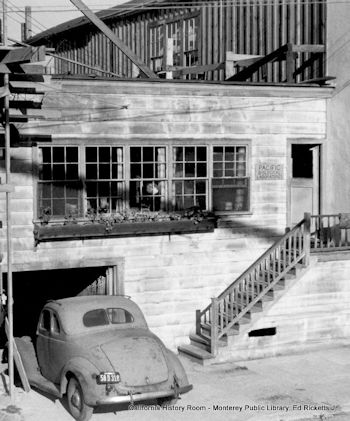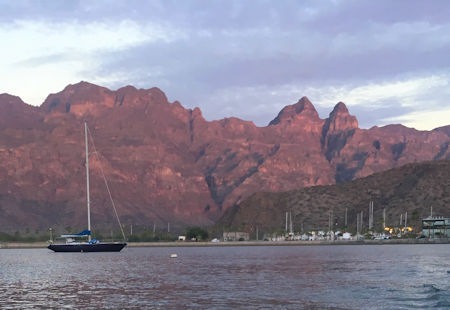 |  |
By Greg Niemann

John Steinbeck, California’s most prominent gift to the world of literature, was yet another American attracted to the wilds of Baja California. Even before the Nobel Prize winner went on his epic trip into the Sea of Cortez, he felt an affinity with our neighbors to the south.
The Forgotten Village
Steinbeck’s love for Mexico, and also wanting to write a movie without any Hollywood involvement, led to the documentary The Forgotten Village. The film, directed by Herbert Kline and Alexander Hammid, and narrated by Burgess Meridith, was produced in 1940. Steinbeck’s empathy with living conditions in American migrant camps and Mexican farm laborers led to the movie which depicts a clash between traditional Mexican village life and encroaching modernism.
The initial reaction to the movie was shocking. The New York State Board of Censors called the movie “indecent,” the “indecency” consisting of a childbirth scene, and a scene of the mother nursing the infant. But Steinbeck pointed out: “In the picture there is no nudity. No suggestiveness and no actual birth is shown. The indecent fact which seems to have upset the board is that child birth is painful in primitive communities where there is no medical care, not only painful but dangerous.” The movie was finally released in late 1941, impressing critics. Steinbeck would always be proud of The Forgotten Village.
While the movie was under production, Steinbeck had the opportunity to explore Baja California in depth, thanks to his good friend, the biologist Edward F. Ricketts (Better known to readers as “Doc” in Cannery Row and other books.)
Ed “Doc” Ricketts
In the 1930s and 1940s, Ed Ricketts was a big influence on Steinbeck, who at Stanford University had also studied marine biology. They took brief excursions together along the California coast to collect biological specimens, which Ricketts sold for a living. For years, Ricketts made numerous trips from Canada to Baja California which resulted in his book Between Pacific Tides (1939—Stanford University Press).
Ricketts made several trips to Baja California beginning in 1925. He mentions finding numerous octopuses: “Between Tijuana and Ensenada we have found octopuses very numerous in April, May, and December, in several different years. In December 1930 they were so abundant that one could count finding a specimen under at least every fourth rock overturned.

In March 1931, Ricketts, with noted Swedish biologist Torsten Gislen and their wives, went to Baja California in Ed’s modified Packard. They mention exploring the kelp forest, sea caves, and tide pools around the Halfway House, and also the bay and estuary at Ensenada. In 1936 Steinbeck accompanied his biologist friend on an auto excursion to the Halfway House area.
Sea of Cortez: A Leisurely Journal of Travel and Research
Ricketts planned a grand trip around Baja California and into the Sea of Cortez to collect marine invertebrates and invited his writer friend. Steinbeck’s Pulitzer Prize winning novel The Grapes of Wrath had just been released and the publicity-shy novelist was anxious to get away.
In March 1940, aboard the leased sardine boat Western Flyer, the duo (along with Steinbeck’s first wife Carol, skipper Tony Berry, engineer Tex Travis, and two crewmen, Sparky Enea and Tiny Colleto) left Monterey on the historic trip.
The resulting 1941 book The Sea of Cortez: A Leisurely Journal of Travel and Research (Viking Press) was co-authored with Ricketts. Well annotated, the 598-page book contains numerous color and black and white photo plates of the various specimens collected. The reminiscences, musings, and philosophy throughout are pure Steinbeck at his best.
The author followed it up with The Log from the Sea of Cortez, which also includes a profile of Ed Ricketts. The Log itself is exciting, thoughtful, and revealing. For example, Steinbeck wrote, “We said, ‘Let’s go wide open. Let’s see what we see, record what we find, and not fool ourselves with conventional scientific strictures. We could not observe a completely objective Sea of Cortez anyway, for in that lonely and uninhabited Gulf our boat and ourselves would change it the moment we entered.’”
The literary sage also noted brighter skies and a brilliant ocean once south of the border. He wrote: “Below the Mexican border the water changes color; it takes on a deep, ultramarine blue—a washtub bluing blue, intense and seeming to penetrate deep into the water; the fishermen call it ‘tuna water.’”
The expedition circled the cape, stopping at the tuna cannery in Cape San Lucas (not much town in 1940), and went collecting up the peninsula side of the gulf. They stopped in La Paz, Loreto, San Lucas Cove, and up past Bahía de los Ángeles, collecting and annotating as they went.

They recruited a little help in La Paz. After paying a few little boys for gathering, Steinbeck noted: “The population of small boys at La Paz is tremendous, and we had business dealings with a good part of it. Hardly had we returned to the Western Flyer and begun to lay out our specimens when we were invaded. Word had spread that there were crazy people in port who gave money for things a boy could pick up on the rocks. We were more than invaded—we were deluged with small boys bearing specimens. They came out in canoes, in flatboats, some even swam out, and all of them carried specimens.”
Later, while moored at Puerto Escondido, Steinbeck and Ricketts were invited by a few locals to head into the rugged Sierra de la Giganta for an overnight camping trip. Aboard mules and then scrambling afoot, they explored a steep boulder-filled canyon. Even though called Tabor Canyon, many people today refer to the idyllic setting as Steinbeck Canyon. John wrote, “After a short climb we emerged on a level place in a deep cleft in the granite mountains. In this cleft a tiny stream of water fell hundreds of feet from pool to pool. There were palm trees and wild grapevines and large ferns, and the water was cool and sweet. This little stream, coming from so high up in the mountains and falling so far, never had the final dignity of reaching the ocean.”
Steinbeck Canyon (Tabor Canyon) today is a favorite hiking destination for Loreto area tour groups.
They crossed the gulf, visited Guaymas on the mainland, and then returned to Monterey after a six-week trip that filled numerous specimen jars and uncovered a wealth of information, including 35 new marine species.
The Pearl
In La Paz, Steinbeck was intrigued by the pearl industry and heard heart-breaking tales about the difficult lives of the pearl fishermen. The industry and the setting led to one of Steinbeck’s most famous stories, The Pearl (Viking Press—1947). The Pearl became a movie with both English and Spanish versions (La Perla).
In addition to the aforementioned books, years later crewman Sparky Anea came out with a book, With Steinbeck in the Sea of Cortez: A Memoir of the Steinbeck/Ricketts Expedition. (Sand River Press—1991). It’s an eye-opening account from a different point of view. Enea also brings the readers up to date from the aftermath of the trip to his publishing. He mentions, “When we docked in Monterey in the morning, it seemed as if everyone was there to meet us. The dock was full of people.” He adds, “But we didn’t need another party. We were just getting back from a six-week party in the Sea of Cortez.”

The group talked about another trip back to Baja California but World War II came along, Steinbeck and Carol divorced in 1941; he remarried in 1942, moved to New York, and the camaradarie began to dissolve.
A huge shock came in 1948 when Ed Ricketts’ car, apparently stalled on the railroad tracks in Monterey, was struck by the Southern Pacific Railway’s Del Monte Express. He died three days later, just three days shy of his 52nd birthday.
Word of his friend’s death numbed Steinbeck. The author, then living in New York, returned to the lab and, like other grieving friends, retrieved some personal items, including their correspondence.
In a 1951 tribute, Steinbeck explained why Ricketts’ death had such a searing impact on him and so many others: “He was different from anyone and yet so like that everyone found himself in Ed, and that might be one of the reasons his death had such an impact. It wasn’t Ed who had died but a large and important part of oneself.”
Another account of the Ricketts/Steinbeck journey to Baja was published as recently as two years ago by Kevin M. Bailey, The Western Flyer (University of Chicago Press, 2015).
About Baja, Steinbeck later commented, “Trying to remember the Gulf is like trying to re-create a dream…There is always in the back of our minds the positive drive to go back again. If it were lush and rich, one could understand the pull, but it is fierce and hostile and sullen. The stone mountains pile up to the sky and there is little fresh water. But we must go back if we live, and we don’t know why.”
Unfortunately, Steinbeck who died in 1968, never returned to Baja.
About Greg
Greg Niemann is the author of Baja Fever, Baja Legends, Palm Springs Legends, Las Vegas Legends, and Big Brown: The Untold Story of UPS. Visit Greg's website.

Good quality, affordable, and easily accessible insurance for Mexico!

Took just a few minutes on line. Easy even for a 75 year old

I have used Baja Bound for insurance for many years. Their online process is easy and cost...